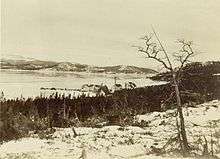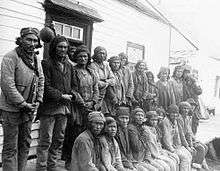Davis Inlet
Davis Inlet was a Naskapi community in the Canadian province of Newfoundland and Labrador, formerly inhabited by the Mushuau Innu First Nation. It was named for its adjacent fjord, itself named for its non-aboriginal discoverer, John Davis, who in 1587 charted the region as part of England's ongoing efforts to find a Northwest Passage to the Pacific.


Settlement
The community developed around 1924 during a period of sparse caribou populations when the Innu began spending their summers along the shoreline of Davis Inlet. This location was chosen because of its accessibility, its offering of other non-caribou food sources, and the presence of a Hudson's Bay Company trading post that was able to supply traps, ammunition, tobacco, butter, sugar and flour to the Innu in exchange for furs. Davis Inlet was also frequented by Roman Catholic missionaries, whom the Innu found helpful. In the following years the Innu began transitioning from a nomadic lifestyle to a more sedentary one, travelling inland to hunt caribou in the fall and winter, but spending the summer at Davis Inlet. Without prior consultation, in 1948 the Newfoundland government relocated the Innu of Davis Inlet to the small community of Nutak in northern Labrador, promising better opportunities for fishing and hunting. However, two years later the Innu surprised government officials by returning to Davis Inlet, having made their way back through the interior of Labrador on foot. The government continued to consider relocation of the Innu, and in 1967 with the urging of government officials and missionaries the Innu of Davis Inlet moved and settled on Iluikoyak Island on a year-round basis, establishing the Davis Inlet community (known as Utshimasits by the Innu).[1]
Social problems
Problems with the new site for the Davis Inlet community began as early as 1969. Settling on Iluikoyak Island inhibited the ability of the Innu to continue their traditional means of providing food by hunting caribou on the mainland and the community struggled adapting to its new-found dependence on store-bought food. Iluikoyak Island is solid rock, and because working the rock was seen as too expensive, the houses provided by the government for settlement were made without basements or water and sewage systems.[2] The houses were also small, poorly constructed, and not designed to house extended families. It was soon discovered that water supply on the island was insufficient, and most of it contaminated. Waste began to pile up, and diseases such as tuberculosis began to appear.[1]
Many of the adults in Davis Inlet battled alcoholism and on Valentine's Day, 1992, six unattended children aged between six months and nine years died in a house fire while their parents were drinking at a Valentine's Day dance.[3] About one-quarter of all adults in Davis Inlet had attempted suicide in the previous year, and between 1973 and 1995 fifty lives were lost in the community of 465 in alcohol-related deaths.[1][2] As a result of the February 1992 fire, the Mushuau Innu and Innu Nation held an internal enquiry published as Gathering Voices: Finding Strength to Help Our Children.[4]
Inhalant abuse was another problem in Davis Inlet, with 47 children being recognized as chronic abusers of solvents, some as young as age 5. In 1993, a video (recorded by Simeon Tshakapesh who later served as Chief of Davis Inlet) was released to the media of six children in Davis Inlet between the ages of 11 and 14 huffing gasoline in an unheated shack in winter and shouting that they wanted to die.[5][6] Shamed by the negative publicity and international outcry surrounding the events in 1993, the Canadian government agreed to move the Innu to mainland Labrador, and in 2002 at a cost of nearly $200 million the community of Davis Inlet was relocated to Natuashish. However, the problems of suicide, alcohol and solvent abuse followed the community and in 2008 they voted to outlaw alcohol entirely.[2] The prohibition bylaw was upheld in a subsequent referendum in March 2010.[7]
In November 1999, international native rights organization Survival International released a report on the Labrador lnnu entitled Canada's Tibet: The Killing of the Innu. The report called the Innu of Davis Inlet "the most suicide-ridden people of the world".[8]
In November 2000, the community, along with Sheshatshiu, took the unprecedented step of asking the Canadian federal government to step in and assist with a local addiction crisis.[9] In 2001, 35 Innu children from Davis Inlet were sent to the former Grace Hospital in St. John’s for treatment for gas sniffing.[10] According to paediatrician and geneticist Dr. Ted Rosales, who served on the treatment team in 2001, approximately 24 of the youths were diagnosed as having FASD (fetal alcohol spectrum disorder).[11]
The Davis Inlet crisis was profiled in the 1996 documentary film Utshimassits: Place of the Boss.[12]
References
- Press, Harold (1995). "Davis Inlet in Crisis: Will the lessons ever be learned?" (PDF). Canadian Journal of Native Studies. 15 (2): 187–209. Archived from the original (PDF) on 21 July 2011. Retrieved 17 June 2011.
- Mintz, Eric; Livianna Tossutti; Christopher Dunn (2011). "Undue Hardship: The Innu of Davis Inlet". Democracy, Diversity, and Good Government: An Introduction to Politics in Canada. Toronto: Pearson Canada. p. 231. ISBN 978-0-13-235061-7.
- "Davis Inlet: Innu Community in Crisis". CBC Digital Archives. Canadian Broadcasting Corporation. 28 Jan 1993. Retrieved 17 June 2011.
- CBC, "Natuashish votes to keep alcohol ban", March 26, 2010
- "Witness focuses on Innu move to remote Davis Inlet". Vancouver Sun, February 10, 1996.
Further reading
- Burns, Aušra (Spring 2006). "Moving and Moving Forward: Mushuau Innu Relocation from Davis Inlet to Natuashish". Acadiensis. 35 (2): 64–84. JSTOR 30303231.
- Dalsbø, Elisabeth Thørring (Spring 2010). "We were told we were going to live in houses" : relocation and housing of the Mushuau Innu of Natuashish from 1948 to 2003 (PDF) (Master of Philosophy in Indigenous Studies). University of Tromsø.
- Pollard, Deidre (2006). The political rhetoric of social problems: gasoline sniffing among the Innu of Labrador. Masters thesis, Memorial University of Newfoundland.
- Samson, C., J. Wilson, & J. Mazower (1999). Canada's Tibet: the Killing of the Innu. London: Survival International.
External links
- Davis Inlet: Innu Community in Crisis (Video footage of 1993 incident), CBC.ca, 28 Jan 1993.
- Walker, John (1996). Place of the Boss: Utshimassits. National Film Board of Canada.